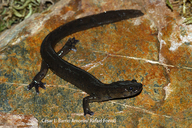|
Description
This robust salamander is normally 150-200 mm in length. Skin smooth, with 11 costal grooves. Coloration dark olive-brown, green-brown, or grey-brown, speckled with fewer large pigmented dots. The belly is milk-yellow, with some dark tiny dots. Vomerine teeth in two short arched, transverse rows, far beyond the choanae. 4 fingers and 5 toes. Tips of the digits covered with a brown horny epidermis. Premaxillary fontanelle large. Labial fold strong. Distribution and Habitat
Country distribution from AmphibiaWeb's database: China
This species occurs in mountain regions of central and western China such as Henan province (Shangcheng county), Shanxi province (Pingli county), Sichuan province (eastern part), and Hubei province (western part). Life History, Abundance, Activity, and Special Behaviors
The salamander lives in mountain, cold, slow-flowing streams, altitude 910-2350 meters. The streams are normally surrounded by rich plants and have plenty of rocks in the bed. The adult salamanders are mainly aquatic, normally hiding under the rocks in water; some adults walk on land occasionally. Feed on aquatic invertebrate larvae. The species breeds between the end of March and the beginning of April. The female lays a pair of jelly-like egg sacs containing 12-42 eggs. The clutch is normally stuck to the bottom of rocks. Cytology:
Chromosome number 2n=64. Trends and Threats
This species seems to be abundant within its distribution range. However, recently there are some reports that a few people are beginning to capture and sell them as fake "small chinese giant salamanders" to restaurants through illegal trade. If such a situation continues, these animals will face serious threats.
Originally submitted by: Peng Zhang (first posted 2007-03-12)
Edited by: JG (2007-10-27)Species Account Citation: AmphibiaWeb 2007 Liua shihi: Wushan Salamander <https://amphibiaweb.org/species/3903> University of California, Berkeley, CA, USA. Accessed Jun 13, 2025.
Feedback or comments about this page.
Citation: AmphibiaWeb. 2025. <https://amphibiaweb.org> University of California, Berkeley, CA, USA. Accessed 13 Jun 2025.
AmphibiaWeb's policy on data use.
|





 Raffaëlli Account
Raffaëlli Account Map of Life
Map of Life